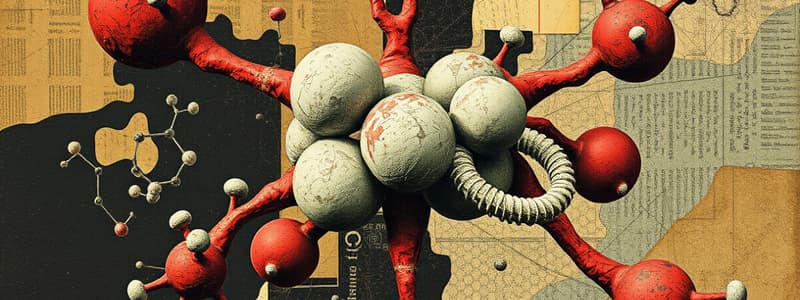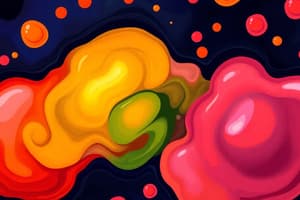Podcast
Questions and Answers
What is the primary function of the proteins classified as globular hemoproteins?
What is the primary function of the proteins classified as globular hemoproteins?
- To facilitate electron transfer in oxidation-reduction reactions
- To catalyze the breakdown of hydrogen peroxide
- To stabilize carbon dioxide effects in tissues
- To transport oxygen from the lungs to tissues (correct)
Which structure is characteristic of hemoglobin?
Which structure is characteristic of hemoglobin?
- Multiple subunits that cannot bind O2
- Two polypeptide chains that are identical
- Four polypeptide chains consisting of two alpha and two beta chains (correct)
- One polypeptide chain with a single heme group
What role do distal groups play in the function of globular hemoproteins?
What role do distal groups play in the function of globular hemoproteins?
- They catalyze the breakdown of hydrogen peroxide.
- They facilitate the release of carbon dioxide from tissues.
- They enhance the electrons transport process.
- They stabilize the binding of oxygen to iron in the heme group. (correct)
Which of the following is NOT a characteristic of cytochromes?
Which of the following is NOT a characteristic of cytochromes?
How do allosteric effectors influence hemoglobin's function?
How do allosteric effectors influence hemoglobin's function?
What percentage of the myoglobin chain is folded into α-helices?
What percentage of the myoglobin chain is folded into α-helices?
Which amino acids are primarily located on the interior of myoglobin?
Which amino acids are primarily located on the interior of myoglobin?
What is the primary function of myoglobin?
What is the primary function of myoglobin?
Which structure is terminated by proline within myoglobin?
Which structure is terminated by proline within myoglobin?
Which condition is characterized by an abnormal form of hemoglobin affecting red blood cells?
Which condition is characterized by an abnormal form of hemoglobin affecting red blood cells?
Which specific residue is found in the crevice of myoglobin, contributing to its binding site?
Which specific residue is found in the crevice of myoglobin, contributing to its binding site?
What is the role of allosteric effects in hemoglobin function?
What is the role of allosteric effects in hemoglobin function?
Where are polar amino acids primarily located in myoglobin's structure?
Where are polar amino acids primarily located in myoglobin's structure?
What is the primary structural configuration of hemoglobin?
What is the primary structural configuration of hemoglobin?
In the T form of hemoglobin, what is the characteristic feature regarding the binding pocket?
In the T form of hemoglobin, what is the characteristic feature regarding the binding pocket?
Which bonds are disrupted in the transition from the T form to the R form of hemoglobin?
Which bonds are disrupted in the transition from the T form to the R form of hemoglobin?
What is the role of ferrous iron in the structure of hemoglobin?
What is the role of ferrous iron in the structure of hemoglobin?
What is the consequence of the protonation of amino acids in the T form of hemoglobin?
What is the consequence of the protonation of amino acids in the T form of hemoglobin?
When hemoglobin is in the R form, what occurs to the binding pocket?
When hemoglobin is in the R form, what occurs to the binding pocket?
How many bonds can ferrous iron in hemoglobin form with porphyrin nitrogens?
How many bonds can ferrous iron in hemoglobin form with porphyrin nitrogens?
Which amino acid side chain position is involved in iron bonding in hemoglobin?
Which amino acid side chain position is involved in iron bonding in hemoglobin?
What is the primary factor that causes the sigmoidal shape of the oxygen dissociation curve for hemoglobin?
What is the primary factor that causes the sigmoidal shape of the oxygen dissociation curve for hemoglobin?
What is the significance of P50 in terms of oxygen binding in hemoglobin and myoglobin?
What is the significance of P50 in terms of oxygen binding in hemoglobin and myoglobin?
Which factor contributes to a rightward shift in the oxygen dissociation curve?
Which factor contributes to a rightward shift in the oxygen dissociation curve?
How does myoglobin differ from hemoglobin in terms of oxygen release?
How does myoglobin differ from hemoglobin in terms of oxygen release?
What effect does the presence of 2,3-biphosphoglycerate have on hemoglobin's affinity for oxygen?
What effect does the presence of 2,3-biphosphoglycerate have on hemoglobin's affinity for oxygen?
In which condition does hemoglobin exhibit a higher affinity for oxygen, according to the Bohr effect?
In which condition does hemoglobin exhibit a higher affinity for oxygen, according to the Bohr effect?
What is the role of CO2 in the transport of oxygen within the human body?
What is the role of CO2 in the transport of oxygen within the human body?
Which binding interaction between oxygen and hemoglobin is impacted by 2,3-BPG?
Which binding interaction between oxygen and hemoglobin is impacted by 2,3-BPG?
What is the purpose of hyperbaric oxygen therapy in relation to carbon monoxide poisoning?
What is the purpose of hyperbaric oxygen therapy in relation to carbon monoxide poisoning?
What happens to the affinity of hemoglobin for oxygen during chronic hypoxia or anemia?
What happens to the affinity of hemoglobin for oxygen during chronic hypoxia or anemia?
Which of the following statements about myoglobin is NOT true?
Which of the following statements about myoglobin is NOT true?
Which condition is likely to lead to a leftward shift in the oxygen dissociation curve for hemoglobin?
Which condition is likely to lead to a leftward shift in the oxygen dissociation curve for hemoglobin?
How does the binding of carbon monoxide (CO) to hemoglobin affect oxygen transport?
How does the binding of carbon monoxide (CO) to hemoglobin affect oxygen transport?
What is the physiological consequence of the Bohr effect on hemoglobin's oxygen binding under metabolic demands?
What is the physiological consequence of the Bohr effect on hemoglobin's oxygen binding under metabolic demands?
Study Notes
Globular Hemeproteins
- Myoglobin located in heart and skeletal muscle, serves as an oxygen reservoir and carrier.
- Myoglobin features around 80% alpha helical content, consisting of a folded structure with eight alpha-helices (A-H), ending in proline.
Structure of Heme
- Composed of ferrous iron and protoporphyrin IX.
- Iron forms six bonds: four with porphyrin nitrogens, and two additional bonds - one to a histidine side chain and another for oxygen binding.
- Heme plays a critical role in globular hemeproteins including myoglobin and hemoglobin.
Structure and Function of Hemoglobin
- Found exclusively in red blood cells (RBCs).
- Functions to transport oxygen from lungs to tissues, alongside carbon dioxide and hydrogen.
- Hemoglobin consists of four polypeptide chains (2 alpha and 2 beta), enabling cooperative binding of oxygen.
Binding of Oxygen
- Myoglobin binds one heme and one oxygen molecule with higher affinity compared to hemoglobin, which binds four oxygen molecules.
- Oxygen-dissociation curve illustrates myoglobin’s hyperbolic binding compared to hemoglobin's sigmoidal curve.
Allosteric Effect
- Hemoglobin is influenced by allosteric effectors such as pO2, pH, pCO2, and 2,3-biphosphoglycerate (2,3-BPG).
- Cooperative binding in hemoglobin facilitates increased oxygen affinity as oxygen binds to successive heme sites.
Oxygen Dissociation and P50 Value
- P50 indicates the partial pressure of oxygen required to achieve half-saturation of binding sites: 1 mmHg for myoglobin and 26 mmHg for hemoglobin.
- Myoglobin shows hyperbolic shape in the oxygen dissociation curve; as oxygen is released, the binding behavior shifts right or left depending on oxygen levels.
Bohr Effect
- The release of oxygen occurs with decreased pH or increased pCO2, lowering hemoglobin's oxygen affinity and shifting the curve to the right.
- Higher pH or decreased pCO2 increases affinity, shifting the curve to the left, enhancing oxygen binding.
Role of 2,3-BPG
- 2,3-BPG is an important regulator of oxygen binding in hemoglobin, reducing oxygen affinity for greater unloading.
- Increased levels of 2,3-BPG occur during chronic hypoxia or anemia, allowing better oxygen release in tissues.
- Stored blood has low 2,3-BPG, resulting in high oxygen affinity, hence poor oxygen release during transfusions.
Binding of CO2 and CO
- Most CO2 in blood is converted to bicarbonate ion (HCO3) for transport; some binds to hemoglobin as carbamate at N-terminal amino group.
- Carbon monoxide (CO) binds tightly (restorably) to hemoglobin, forming carboxyhemoglobin with a greater affinity than oxygen, posing a risk to smokers.
- Treatment for CO poisoning includes hyperbaric oxygen therapy to promote dissociation of CO.
Summary of Oxygen Binding Changes
- Shift to the left in the oxygen dissociation curve indicates increased oxygen affinity (higher pH, lower pCO2, decreased 2,3-BPG).
- Shift to the right indicates decreased affinity (lower pH, increased pCO2, increased 2,3-BPG), aiding oxygen release in metabolically active tissues.
Studying That Suits You
Use AI to generate personalized quizzes and flashcards to suit your learning preferences.
Related Documents
Description
Test your knowledge on the structure and function of globular proteins, specifically myoglobin, as discussed in Dr. Jandoc's lecture. This quiz will cover key concepts such as heme structure, oxygen transport, and the formation of methemoglobin.




